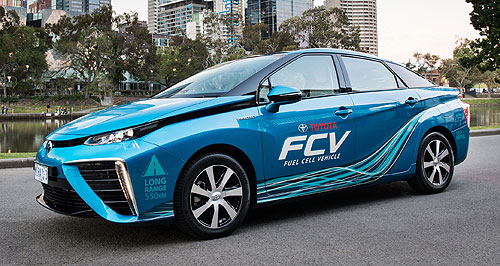Make / Model Search
News - ToyotaToyota backs hydrogen economyBorn again: Toyota’s one-time car manufacturing plant is being redeveloped for a variety of company purposes, including hydrogen production using electricity generated from existing solar panels on the former factory roof. Former Toyota factory to generate hydrogen from rooftop solar for vehicle fuel20 Mar 2019 TOYOTA Australia hopes a $7.4 million investment in a hydrogen production and vehicle refuelling centre at its former car manufacturing site at Altona, Victoria, will help to trigger the development of more hydrogen infrastructure across Australia to pave the way for the introduction of hydrogen fuel cell electric vehicles (FCEVs) such as its Mirai.
To date, Australia’s biggest motor company has been stymied from offering the Mirai for sale or lease in this market because of the lack of hydrogen refuelling stations.
A six-month real-world trial by a fleet of three Mirais lent by Toyota to Hobson City Council in Melbourne’s west last year was supported by a mobile hydrogen refuelling station parked at the Altona plant after it ceased car production in October 2017.
Now, the federal Australian Renewable Energy Agency (ARENA) will contribute $3.1 million to the Toyota Hydrogen Centre that will produce up to 60kg of hydrogen a day from water by electrolysis using electricity from a 500kW solar array that was installed on the roof of the former factory a few years ago, before the decision was taken to close production there.
Due to open by the end of 2020, the facility will be the first FCEV refuelling operation in Australia to produce hydrogen directly from its own renewable energy and then supply it to customers through Victoria’s first commercial-grade vehicle hydrogen refuelling station.
Hyundai operates a hydrogen refuelling station in Sydney for its Nexo hydrogen fuel cell car trials, but does not produce the gas on site. Last year, it said it was in talks with suppliers to development more refuelling sites, perhaps starting in Canberra.
Toyota Australia public affairs manager Brodie Bott told GoAuto that the hydrogen centre was a key part of Toyota’s advocacy role in the development of the Australian hydrogen economy.
He said Toyota would like to introduce hydrogen fuel cell cars such as the Mirai to Australia, but unlike some overseas markets such as parts of the United States, Canada and Japan, commercial refuelling stations are non-existent here.
Mr Bott said Toyota saw the Altona development as a first step towards wider application of hydrogen vehicle technology across Australia.
The Labor Party has pledged $1 billion towards such infrastructure via the Clean Energy Finance Corporation, should it win government at the next federal election.
In December, the Council of Australian Governments (COAG) Energy Council announced that it would develop a national hydrogen strategy.
A report commissioned by ARENA suggests Australia could generate up to $10 billion in exports and generate up to 16,000 new jobs over the next 20 years if it ramps up hydrogen production using renewable energy from wind and solar.
The Altona hydrogen facility will include batteries to store electricity during daylight hours, along with an education centre with live presentations of the hydrogen manufacturing and refuelling process.
The hydrogen development will be part of a wider Toyota Centre of Excellence at the former plant where a training centre has already been developed in the former factory administration building. Other facilities are under construction, including some in a redevelopment of the former powertrain production plant.
Drawing power from Toyota’s own rooftop solar panels gets around one of the main criticisms of hydrogen production, that it is energy intensive.
ARENA chief executive officer Darren Miller said the centre would demonstrate hydrogen as a viable fuel source for transport and as an energy storage medium.
“Toyota is helping to pave the way for more renewably powered vehicles in Australia, where the uptake of electric vehicles has been slower than other countries,” he said.
“The demonstration of low-cost hydrogen production and distribution is key to the uptake of hydrogen-powered electric vehicles in areas such as truck, bus and government fleets.
“Australia holds a competitive advantage to play a global role in the emerging hydrogen export market due to our existing expertise and infrastructure.”
Toyota Australia president and CEO Matt Callachor said the hydrogen centre announcement was a step towards the company meeting its target of zero CO2 emissions from sites and vehicles by 2050.
“Hydrogen has the potential to play a pivotal role in the future because it can be used to store and transport energy from wind, solar and other renewable sources to power many things, including vehicles like the Toyota Mirai fuel cell electric vehicle (FCEV),” he said.
“Right now, the biggest factor to the success of hydrogen being widely available is the lack of infrastructure. The sooner we move to a zero emissions society, the better, and Toyota is committed to making this a reality.”
Toyota, Hyundai and Honda have been leading the charge on hydrogen fuel cell cars as a viable alternative to electric vehicles.
The big advantage of FCEVs is that they can be refuelled in a few minutes, similar to petrol cars, compared with extended periods required to charge the batteries of electric cars.
In FCEVs, the hydrogen is fed into a fuel cell which uses it to generate electricity to power the car. The only emission is water.  Read more22nd of January 2019  Labor commits to $1 billion hydrogen planEmerging hydrogen industry the focus of Labor’s latest federal election promise20th of December 2018  Nationwide hydrogen plan outlinedFederal government to develop National Hydrogen Strategy for future FCEV direction |
Click to shareToyota articlesResearch Toyota Motor industry news |











Facebook Twitter Instagram